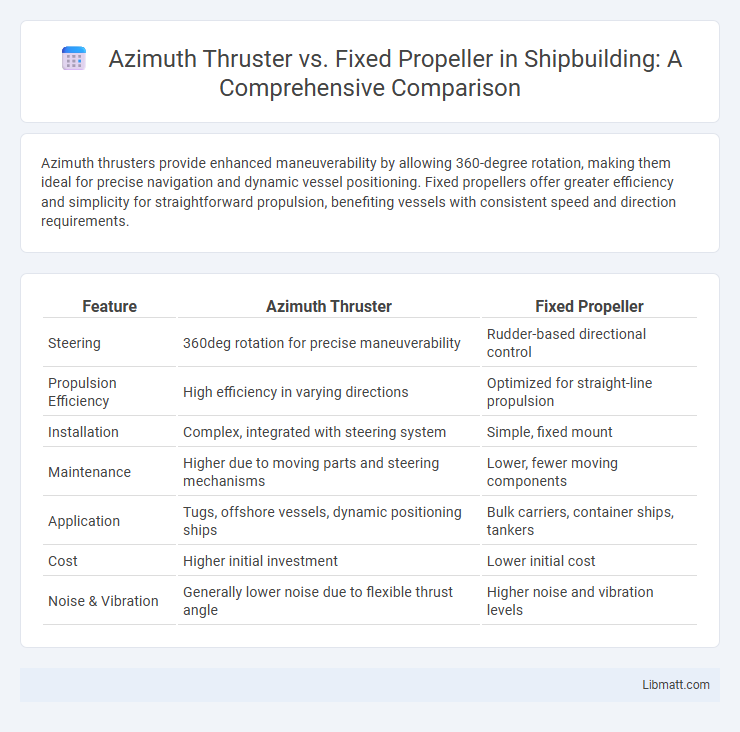Azimuth thrusters provide enhanced maneuverability by allowing 360-degree rotation, making them ideal for precise navigation and dynamic vessel positioning. Fixed propellers offer greater efficiency and simplicity for straightforward propulsion, benefiting vessels with consistent speed and direction requirements.
Table of Comparison
| Feature | Azimuth Thruster | Fixed Propeller |
|---|---|---|
| Steering | 360deg rotation for precise maneuverability | Rudder-based directional control |
| Propulsion Efficiency | High efficiency in varying directions | Optimized for straight-line propulsion |
| Installation | Complex, integrated with steering system | Simple, fixed mount |
| Maintenance | Higher due to moving parts and steering mechanisms | Lower, fewer moving components |
| Application | Tugs, offshore vessels, dynamic positioning ships | Bulk carriers, container ships, tankers |
| Cost | Higher initial investment | Lower initial cost |
| Noise & Vibration | Generally lower noise due to flexible thrust angle | Higher noise and vibration levels |
Introduction to Marine Propulsion Systems
Marine propulsion systems power vessels through water, with azimuth thrusters offering 360-degree rotation for enhanced maneuverability compared to traditional fixed propellers. Azimuth thrusters integrate steering and propulsion in a single unit, providing superior control in tight spaces and dynamic positioning applications. Your choice between these systems impacts vessel efficiency, handling, and operational flexibility depending on navigation requirements.
What is an Azimuth Thruster?
An azimuth thruster is a steerable marine propulsion device that provides 360-degree rotation, enhancing maneuverability and directional control for vessels. Unlike fixed propellers, which have a stationary shaft and require rudders for steering, azimuth thrusters combine propulsion and steering in one unit, improving efficiency and reducing mechanical complexity. These thrusters are widely used in tugboats, offshore supply vessels, and dynamic positioning systems due to their precise handling capabilities.
Understanding Fixed Propellers
Fixed propellers provide consistent propulsion by using a stationary blade configuration attached directly to the shaft, offering reliable efficiency and durability in various marine conditions. Unlike azimuth thrusters, fixed propellers cannot rotate horizontally for steering, which makes them simpler but less maneuverable. Your choice depends on prioritizing straightforward design and fuel efficiency over enhanced directional control.
Key Differences in Design and Function
Azimuth thrusters feature a rotating pod that can swivel 360 degrees, providing precise maneuverability and dynamic thrust direction, unlike fixed propellers which offer constant thrust in a single, unchangeable direction. The design of azimuth thrusters integrates propulsion and steering, enabling superior handling in tight spaces, while fixed propellers rely on separate rudders for navigation. Your choice between these systems depends on vessel requirements for agility and operational environment, with azimuth thrusters favored for complex maneuvering and fixed propellers suited to straightforward propulsion needs.
Maneuverability: Azimuth Thruster vs Fixed Propeller
Azimuth thrusters provide superior maneuverability compared to fixed propellers by allowing 360-degree rotation, enabling precise directional control without the need for a rudder. Fixed propellers rely on rudders for steering, limiting agility, especially in tight or confined spaces. This makes azimuth thrusters ideal for vessels requiring enhanced docking capabilities and dynamic positioning.
Efficiency and Fuel Consumption Comparison
Azimuth thrusters offer superior maneuverability and can improve fuel efficiency by optimizing thrust direction, which reduces drag and enhances vessel handling. Fixed propellers generally provide higher baseline propulsion efficiency at constant speeds but lack adaptability to varying conditions, potentially leading to increased fuel consumption during complex maneuvers. Your choice depends on balancing operational profiles, with azimuth thrusters excelling in dynamic environments and fixed propellers favoring straightforward, steady voyages.
Maintenance and Operational Costs
Azimuth thrusters feature higher initial maintenance costs due to their complex steering mechanisms and hydraulic components, but they offer operational savings through improved maneuverability and fuel efficiency in dynamic positioning tasks. Fixed propellers have lower maintenance expenses because of their simpler design, yet they may incur greater operational costs from increased fuel consumption and less precise handling in confined or variable environments. Choosing between these propulsion systems requires balancing maintenance investment with long-term operational efficiency based on vessel usage.
Applications in Modern Vessels
Azimuth thrusters offer superior maneuverability and are widely used in dynamic positioning vessels, offshore supply boats, and cruise ships for precise navigation in confined waters. Fixed propellers remain prevalent in large container ships and bulk carriers due to their higher propulsion efficiency and simpler mechanical design. The choice between azimuth thrusters and fixed propellers largely depends on vessel type, operational requirements, and the need for enhanced steering control versus fuel efficiency.
Environmental Impact Considerations
Azimuth thrusters offer superior maneuverability and fuel efficiency, reducing emissions and minimizing environmental impact compared to fixed propellers, which often generate higher fuel consumption and underwater noise pollution. Their ability to optimize thrust direction lowers fuel use, contributing to decreased carbon footprints and less marine ecosystem disruption. Choosing an azimuth thruster can enhance your vessel's sustainability profile by aligning with stricter regulations on emissions and underwater noise.
Choosing the Right Propulsion: Factors to Consider
Choosing the right propulsion system involves evaluating maneuverability, efficiency, and operational environment; azimuth thrusters offer superior 360-degree steering and precise control ideal for vessels requiring high maneuverability, while fixed propellers provide robust efficiency and simplicity for straightforward navigation routes. Consider your vessel's size, typical operating conditions, and maintenance capacity, as azimuth thrusters often demand higher initial investment and upkeep compared to fixed propellers. Your decision should balance performance needs against cost-effectiveness to optimize propulsion for your specific maritime application.
Azimuth thruster vs fixed propeller Infographic

 libmatt.com
libmatt.com